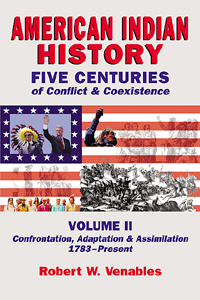Description
American Indian History chronicles the dynamic process of interaction among Indian nations, Europeans and the United States during the past five centuries. Through his meticulous research and excellent narrative style, Robert Venables, Ph.D., makes this history come alive.
Volume II: Confrontation, Adaptation & Assimilation, 1783-Present continues the saga of Indian-U.S. government relations, beginning with the end of the Revolutionary War, when the United States turned on both its former Indian enemies and allies. The Policy of Removal forced most Indian peoples to lands west of the Mississippi. New policies such as the Dawes Act of 1887 succeeded in breaking up the communal land holdings of many Indian nations. The tragic end of the era’s struggles occurred at Wounded Knee, where Lakota followers of the Ghost Dance religion were slaughtered by the Army.
During the first half of the 20th century different Indian programs reflected the goals of the United States government more than they recognized the variety of Indian perspectives. After World War II, U.S. policies such as the relocation of thousands of Indians to urban areas and the attempted “termination” of treaty rights and reservations eventually forced a choice between assimilation and political resistance. Treaty rights and land claims demonstrate how the present day continues past history, even as new controversies, such as casino gambling on Indian reservations, arise. Because Indian America remains diverse, all the issues remain complex.






Reviews
There are no reviews yet.